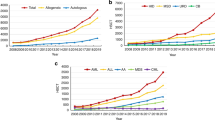Abstract
Bone marrow and stem cell transplantation in Jordan has been performed since the 1990s, but the first comprehensive program was established at King Hussein Cancer Center (KHCC) in March 2003. The program, in addition to other health care institutions in Amman, serves approximately 5.6 million Jordanians. Also, we treat several patients per year from neighboring Arab countries. The program at KHCC performs an average of 80 transplants per year. During the past 4 years 320 patients received transplants at KHCC; 26% of them received an autologous graft and 74% allogeneic grafts. Of the allogeneic grafts 91% were taken from matched family members, 6.7% were haploidentical from one of the parents, and 2.3% were from an unrelated donor or umbilical cord blood. The actuarial overall survival among all patients has been around 65%. The most common indication for transplantation at KHCC was leukemia/MDS followed by benign nonmalignant hematological/immune deficiency/metabolic disorders, with thalassemia major being the most common among this group. The cost of SCT is variable and depends on many factors including the type of transplant and the attending post-transplant complications. The average charge for autologous transplant (both adults and pediatrics) is 24 695 JD (one JD equals 1.42 USD), and the average charge for allogeneic transplant (both adults and pediatrics) excluding haploidentical transplant is 46 787 JD. We have not noticed any peculiar patterns of complications following BMT; however, we have seen a high incidence of chronic GVHD following minitransplant with fludarabine and single-dose TBI (Seattle protocol). At the inception of the program, invasive fungal infection mainly related to building construction, and central line complications were significant. Measures implemented to control such complications were successful to a large extent. We report our results to the EBMT group and we are accredited as an unrelated transplantation center. Although from a young program, our group has presented abstracts to international conferences.
This is a preview of subscription content, access via your institution
Access options
Subscribe to this journal
Receive 12 print issues and online access
$259.00 per year
only $21.58 per issue
Buy this article
- Purchase on Springer Link
- Instant access to full article PDF
Prices may be subject to local taxes which are calculated during checkout
Similar content being viewed by others
Author information
Authors and Affiliations
Corresponding author
Rights and permissions
About this article
Cite this article
Abdel-Rahman, F., Hussein, A., Rihani, R. et al. Bone marrow and stem cell transplantation at King Hussein cancer center. Bone Marrow Transplant 42 (Suppl 1), S89–S91 (2008). https://doi.org/10.1038/bmt.2008.126
Published:
Issue Date:
DOI: https://doi.org/10.1038/bmt.2008.126
Keywords
This article is cited by
-
Worldwide Network for Blood and Marrow Transplantation (WBMT) perspective: the role of biosimilars in hematopoietic cell transplant: current opportunities and challenges in low- and lower-middle income countries
Bone Marrow Transplantation (2020)
-
Infections with the 2009 H1N1 influenza virus among hematopoietic SCT recipients: a single center experience
Bone Marrow Transplantation (2011)
-
Special issues related to hematopoietic SCT in the Eastern Mediterranean region and the first regional activity report
Bone Marrow Transplantation (2009)



